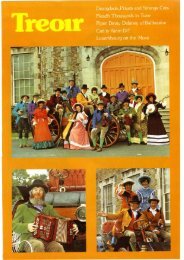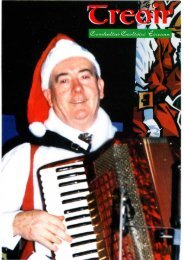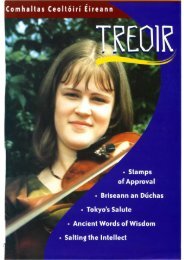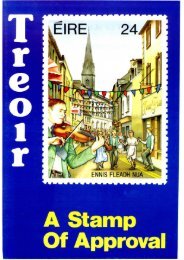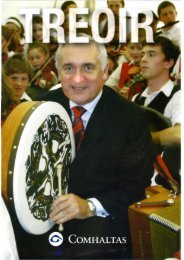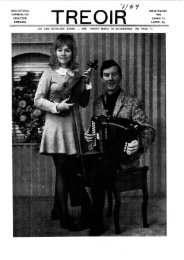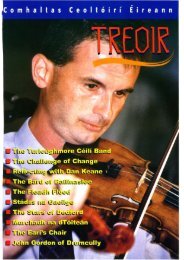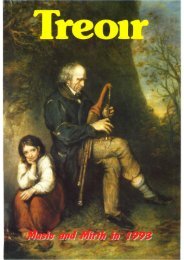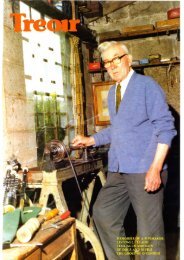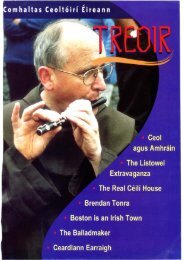sligo for all-ireland? - Comhaltas Archive
sligo for all-ireland? - Comhaltas Archive
sligo for all-ireland? - Comhaltas Archive
- No tags were found...
Create successful ePaper yourself
Turn your PDF publications into a flip-book with our unique Google optimized e-Paper software.
daughter, Rosemary. She made severalappearances with her father in concertsand on television. Perhaps it was herclose association with talented artistesin the top echelon that gave her afeeling of being overshadowed in thetraditional scene and caused her to seeka career in a more creative <strong>for</strong>m of art.It was towards this end that she joinedthe Grafton Academy in Dublin tostudy dress designing and graduatedwith honours.When Hugh and his wife, May, returnedto Donegal in 1964 he irrunediatelylaunched himself into the revival of tra- .ditional music, then initiated by <strong>Comhaltas</strong>Ceolt6iri. He joined the CrossroadsBranch and was elected chairman.One of his ftrst acts was to take a youngmusician, Frank Kelly, under his wing.History was repeating itself. His protegewent on to become All-Ireland. champion.Hugh has spent a lifetime promotingtraditional music, fostering a love of aculture that bonds exiles together inevery country in the world. Today, atthe venerable age of eighty he is still,thankfully, very much to the <strong>for</strong>e.BOGBUTIEREamonn b hArgainHaving spent some time working Inthe bog in Lixnaw during the year, itbrought to mind the various fmdingsthat were made and more than likely arestill being made in the bogs that are soplentiful around this country of ours.But I suppose one rarely fmds anythingstranger than a substance which isknown as "bog butter".While we cannot claim it as altogetherof Milesian origin, it is to a certainextent "ours" as the preponderatingnumber of fmds recorded are obtainedin this country. The National Museumin Dublin showed me a fme specimen ofthis ancient butter which was discoveredduring the past century by people engagedin turf-cutting. The bog butterwas dug out of banks that appearedcomposed of firm bog from considerabledepths beneath the present surfaceof the ground, such as ten, ftfteen oreven eighteen feet deep.Needless to say, this practice has passedinto oblivion and cannot be rememberedeven by the people of two generationsago. It is interesting that such acustom was~ alSo carried cmf in placeslike Scotland and Iceland. The Icelandiccustom may date from those ageswhen Irish missionary priests and wanderinglaymen kept in close contact betweenboth countries; they were regularlyexchanging ideas and no doubt discussedtheir ideas on butter and butterpreservation.The custom of burying butter in bogsis of considerable interest, though it hasnever received the study that the questionsraised deserve. The two main problemsassociated with "bog-butter" arethose of dating and origin. Interestinglyenough, the main belt of fmds lies aiongthe bogs of the south-ern midlands, witha secondary group in the west. Onlycomparatively few fmds have beenreported from the north and none fromDonegal. The period of origin of the. custom is so far u.nknown but the know-ledge of butter-making must go back along way. in man's economy; or it maybe assumed that the making of cheesewas also known at an early period. Asa reason <strong>for</strong> the practice, varioustheories may be suggested, namely thatit was buried <strong>for</strong> preservation until theannual periods of shortage, in otherwords, that it was the· old equivalent ofmodern cold stora'ge . It may have beenburied in order to acquire a taste, or itmay have been' an offering, possibly to"Goibniu", the patron saint of "buttermaking".The idea that butter wasburied to acquire a taste, is a goodone. When the butter was made it hada garlic taste which :was caused by thewild garlic which was eaten by the cattle.Burying it in the bog gave it a sweettaste.As late as this century, the practiceof throwing butter into a lake in thanksgiving<strong>for</strong> healing the cows or horses arestill being done in parts of the country,so the idea that the custom had a semireligioussigniftcanceis also woirqlooking at.We will never know when the custombegan, unless someone fmds a specimenwith a date on it. One fmd had such adate. The fmd was made in TirnakillBog, in County Galway, and it wasdated 1798, and another finding wasdated 1680.The speciments of Irish bog buttercan be divided into two differentclasses, dependent on the manner inwhich it was packed by its owners. Onevariety is contained in hollow vessels ofwood, while the second variety is madeup into various- shaped masses of12irregular <strong>for</strong>m. These are usu<strong>all</strong>y surroundedby a layer of moss and sometimeswith linen cloth. They usu<strong>all</strong>ymeasure 15 inches in length and 10inches in breadth and height, while thelatter might weigh 30 lbs to 40 lbs.Of course , the methods of buttermakingwere much different in thosedays. It was a woman'sjob to make thebutter and they used a bag made fromthe skin of a cow. This bag, which Ihave failed to fmd a name <strong>for</strong>, was sewntogether and the milk was then pouredin. It was then kneaded, shaken andtossed around until the liquid becamesolid. After being put into the ferkinsor casks, it was boiled and only thenwas it ready <strong>for</strong> insertion into the bog.When it was taken from the bog in sixmonths to a year or whenever it was required<strong>for</strong> eating, it was cut into bricklikeshapes with two wooden spatulas.The spatUlas had the seal of a cross onthem to vanish any unwanted spiritsthat might have possessed the butterduring its term in the bog. People usedto believe in those times that the evilspirits used to take the goodness fromthe butter and the crosses in the spatulaswas a kind of protection from them.This pise6g goes back to the fourteenthcentury and a prayer was often said tothe a<strong>for</strong>ementioned "Goibniu", whdwas said to be the patron saint ofbutter-making.In the library of the Royal IrishAcademy in Dublin, there is a paper bythe late Sir William Wilde. In it, hementions that Sir William Petty, in hisenumeration of different articles offood used by the Irish, describes"Butter made rancid by keeping inbogs" and refers also to the " IrishH~dibras" where we read of "Butter toeat with their hog, was seven yearsburied in a bog".



